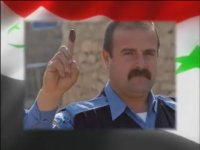Agam's Gecko


Friday, August 08, 2008
AN IMPORTANT DAY
 Tens of thousands filled Rangoon's streets on August 8, 1988 to demand democracy for Burma. |
| T |
he date is 8-8-08, a very important date. The people of Burma, around the world and in their own country, are marking the 20th anniversary of a momentous democracy uprising in their country. (Apparently, there is also some sort of sporting event going on someplace, hosted by the regime which consistently protects the Burmese military junta, keeping it in power to this day.)
At the time the military took control of Burma in 1962, it was considered one of the most developed countries in Asia. By the mid 1980's, it had attained the United Nations status of a "Least Developed Country." In 1987 the superstitious dictator, Ne Win, demonetized currency notes over 10 Kyat, wiping out most people's savings overnight. Ne Win loved the number 9 the way Chinese love the number 8 -- all currency would henceforth be based on multiples of 9.
Protests began shaking the dictatorship, and in July 1988 Ne Win resigned -- assigning a "particularly bloody henchman" to take over. Students at the Institute of Technology protested on their campus and one was shot dead. As the former British Ambassador, Michael Morland recalls, a spark was lit.
Upheaval quickly followed; students and workers announced a general strike as well as a demonstration to commence at the 8th minute of the 8th hour of the 8th day of August (the 8th month) 1988. Thousands and thousands of people mightily fed-up with the years of calamitous miss-rule took to the streets simply to demand democracy – some thousands of those people would pay with their lives.The 8888 movement was the birth of a new consciousness among Burma's people, but the day did not completely belong to them. Sai Win Kyaw was a captain in the Tatmadaw (Burmese Armed Forces), and was among those forces called back to Rangoon to quell the uprising. He was stationed near the US Embassy, and recalls that other troops near City Hall began shooting protesters just before midnight on that day. His troops were called in to clean up the carnage as fire engines washed the bloodstained streets.
 Please note the fixed bayonets. |
Sai Win Kyaw saw a schoolgirl holding a portrait of independence hero Gen Aung San suddenly drop when the first bullet hit her. Then other people started falling. "I will never forget that moment," says the former officer, who joined the Defense Services Academy when he was just 18.The killings went on until August 12, not only in Rangoon but throughout Burma. An estimated 450 officers and soldiers broke ranks, Saw Win Kyaw among them, crossing the line to join the protesters. These continuing defections may have prompted the army to hit hard on September 18. Thousands were killed, Saw Win Kyaw was among those arrested and tortured. He now lives in exile in Thailand.
He began to question why these unarmed people were being killed. "Why were such harsh measures being applied to deal with this kind of situation? I couldn’t understand it." From then on, he says, he stopped taking pride in being a soldier.
The August protests had caused the removal from power of the new leader, U Sein Lwin. The New York Times reported on August 14 that calm was returning to the capital. Familiar methods were used to prevent information from getting out.
Accounts by witnesses of the Burmese crisis have declined since midweek, when the Government ceased issuing tourist visas. Since the turmoil began, Burma has become particularly vigilant in barring the entry of foreign journalists, who have in the past entered the country as tourists.
Tourists arriving in Bangkok from Burma said the people who joined in the protests this week were jubilant. But it was not known how the protesters might direct their new-found political power. The Government said 95 people were killed this week in the unrest, although reliable but unofficial reports have put the death toll in the hundreds.
 |
The Irrawaddy Magazine has more, in Commemorating 8.8.88.
Another uprising for democracy was begun one year ago with small scale protests which were quickly quashed by the successors of the earlier murderers. Buddhist monks picked up the torch and marched in their tens of thousands, growing into hundreds of thousands by September. This too was put down with ruthless violence. Any serious United Nations response has been prevented by a non-democratic country with a Security Council veto. That country is currently holding some sort of party.
A new generation of Burmese remembers what happened 20 years ago, although some of them were not old enough to experience it directly. They call themselves Generation Wave, and they're planning to paint the town red, in memory of the massive loss of life.
Many around the world will be joining them in a Global Day of Action today. Join with them too, at the nearest Chinese and Burmese diplomatic mission. Details here.
.
Labels: Burma











 Our way of saying "thanks" in the Thai way. Here a nak muay Thai (kickboxer) offers respect and thanks for his teacher (wai khru) before a match. This is our local variation on the ubiquitous "hat tip" used in general blog culture.
Our way of saying "thanks" in the Thai way. Here a nak muay Thai (kickboxer) offers respect and thanks for his teacher (wai khru) before a match. This is our local variation on the ubiquitous "hat tip" used in general blog culture.




